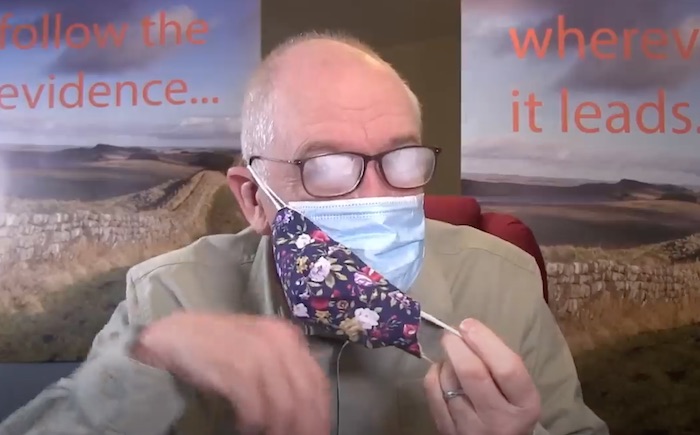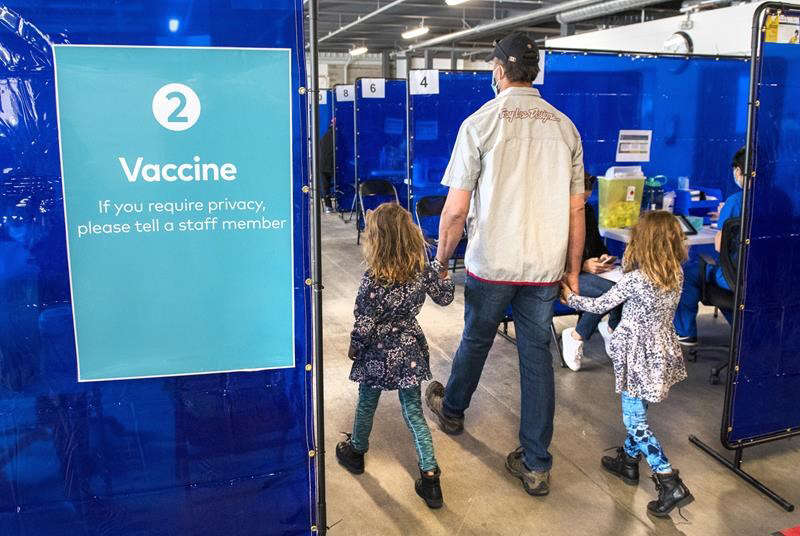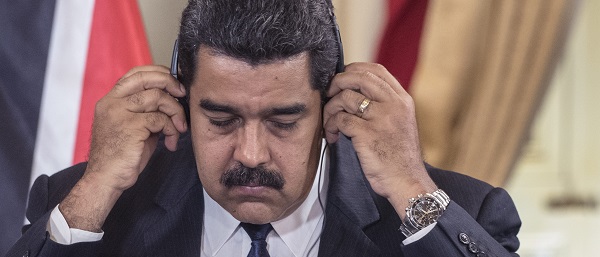COVID-19
“I want to apologize for advocating for the use of masks” – Spread of respiratory illnesses not slowed down by mask use

The study examines the effectiveness of masks and of following a hand hygiene program in reducing the likelihood of acquiring respiratory virus infections such as COVID-19.
British Health Researcher Dr. John Campbell shares the disappointing results in this presentation:
From Dr. John Campbell
From the Cochrane Library
What did we do?
We searched for randomised controlled studies that looked at physical measures to stop people acquiring a respiratory virus infection.
We were interested in how many people in the studies caught a respiratory virus infection, and whether the physical measures had any unwanted effects.
What did we find?
We identified 78 relevant studies. They took place in low‐, middle‐, and high‐income countries worldwide: in hospitals, schools, homes, offices, childcare centres, and communities during non‐epidemic influenza periods, the global H1N1 influenza pandemic in 2009, epidemic influenza seasons up to 2016, and during the COVID‐19 pandemic. We identified five ongoing, unpublished studies; two of them evaluate masks in COVID‐19. Five trials were funded by government and pharmaceutical companies, and nine trials were funded by pharmaceutical companies.
We assessed the effects of:
· medical or surgical masks;
· N95/P2 respirators (close‐fitting masks that filter the air breathed in, more commonly used by healthcare workers than the general public); and
· hand hygiene (hand‐washing and using hand sanitiser).
We obtained the following results:
Medical or surgical masks
Ten studies took place in the community, and two studies in healthcare workers. Compared with wearing no mask in the community studies only, wearing a mask may make little to no difference in how many people caught a flu‐like illness/COVID‐like illness (9 studies; 276,917 people); and probably makes little or no difference in how many people have flu/COVID confirmed by a laboratory test (6 studies; 13,919 people). Unwanted effects were rarely reported; discomfort was mentioned.
N95/P2 respirators
Four studies were in healthcare workers, and one small study was in the community. Compared with wearing medical or surgical masks, wearing N95/P2 respirators probably makes little to no difference in how many people have confirmed flu (5 studies; 8407 people); and may make little to no difference in how many people catch a flu‐like illness (5 studies; 8407 people), or respiratory illness (3 studies; 7799 people). Unwanted effects were not well‐reported; discomfort was mentioned.
Hand hygiene
Following a hand hygiene programme may reduce the number of people who catch a respiratory or flu‐like illness, or have confirmed flu, compared with people not following such a programme (19 studies; 71,210 people), although this effect was not confirmed as statistically significant reduction when ILI and laboratory‐confirmed ILI were analysed separately. Few studies measured unwanted effects; skin irritation in people using hand sanitiser was mentioned.
Dr. John Campbells presentation notes with links:
RCTs did not show a clear reduction in respiratory viral infection with the use of medical/surgical masks.
There were no clear differences between the use of medical/surgical masks compared with N95/P2 respirators in healthcare workers, when used in routine care to reduce respiratory viral infection.
Do physical measures such as hand-washing or wearing masks stop or slow down the spread of respiratory viruses?
https://www.cochranelibrary.com/cdsr/…
Evidence published up to October 2022.
Background Influenza (H1N1) caused by the H1N1pdm09 virus in 2009
Severe acute respiratory syndrome (SARS) in 2003 Coronavirus disease 2019 (COVID-19)
Update of a Cochrane Review last published in 2020.
We include results from studies from the current COVID-19 pandemic.
Main results 11 new RCTs and cluster-RCTs n = 610,872
Bringing the total number of RCTs to 78
Medical/surgical masks compared to no masks
Wearing masks in the community probably makes little or no difference to the outcome of influenza‐like illness
wearing a mask may make little to no difference in how many people caught a flu-like illness/COVID-like illness
Risk ratio (RR) 0.95, (0.84 to 1.09) 9 trials, n = 276,917 participants
Moderate-certainty evidence.
Wearing masks in the community probably makes little or no difference to the outcome of laboratory-confirmed influenza/SARS-CoV-2 RR 1.01, (CI 0.72 to 1.42)
6 trials, n = 13,919 Moderate-certainty evidence
Harms were rarely measured and poorly reported (very low-certainty evidence).
N95/P2 respirators compared to medical/surgical masks
We pooled trials comparing N95/P2 respirators with medical/surgical masks
We are very uncertain on the effects of N95/P2 respirators compared with medical/surgical masks on the outcome of clinical respiratory illness
Compared with wearing medical or surgical masks, wearing N95/P2 respirators probably makes little to no difference in how many people have confirmed flu and may make little to no difference in how many people catch a flu-like illness, or respiratory illness.
Confirmed influenza RR 0.70, (0.45 to 1.10) N = 7,779 Very low-certainty evidence
Influenza like illness N95/P2 respirators compared with medical/surgical masks may be effective for ILI RR 0.82 N= 8,407 Low-certainty evidence
The use of a N95/P2 respirators compared to medical/surgical masks
Probably makes little or no difference for laboratory-confirmed influenza infection RR 1.10 N = 8,407 Moderate-certainty evidence
Restricting pooling to healthcare workers made no difference to the overall findings.
Harms were poorly measured and reported
Discomfort wearing medical/surgical masks or N95/P2 respirators was mentioned in several studies
Very low-certainty evidence
One new RCT Medical/surgical masks were non-inferior to N95 respirators N = 1,009 healthcare workers in four countries, providing direct care to COVID-19 patients.
COVID-19
A new study proves, yet again, that the mRNA Covid jabs should NEVER have been approved for young people.

2.7 million Spanish children and teenagers. ZERO Covid deaths.
Here’s some news from Spanish researchers: contrary to what American health bureaucrats said for years to justify the increasingly insane mRNA “vaccine” experiment, Covid doesn’t kill kids.
—
(More facts, fewer guesses. For pennies a day.)
—
Yes, making categorical statements like “Covid doesn’t kill kids” is foolish.
Look hard enough, and there will be an exception, perhaps a child terminally ill with cancer pushed over the edge by Covid.
But the Spanish study, which was peer-reviewed and published in The Pediatric Infectious Disease Journal, proves yet again that Covid’s risk is too low to measure — not just not to healthy children, but to all children. It is the strongest evidence yet that the oft-repeated claim that Covid has killed 2,100 American children is fiction.¹
The researchers examined medical records from 2.7 million Spanish children and teenagers from mid-2021 through the end of 2022, a period in which the Omicron variant infected almost everyone worldwide with Covid. The vast majority of those kids and adolescents, about 2.2 million, had not been vaccinated.
Yet none of those 2.7 million died of Covid.
None. As in zero.
—
(Good thing we closed the schools!)
(SOURCE)
—
There really isn’t much more to say about the paper, except that the authors couldn’t find any difference for Covid hospitalization rates between vaccinated and unvaccinated kids under 12.
For adolescents 12-17, they calculated about 38,000 mRNA jabs were required to avoid one Covid hospitalization — an absurdly high number given the known short-term side effects of the shots and the potential long-term risks of exposing young people to mRNA.
At this point, any physician who recommends Covid jabs for kids (as a handful, mostly in blue states, still are) should be sued for malpractice.
—
One final note: this week’s immigration articles have gotten a LOT of likes and comments, more than any recent Covid or mRNA pieces. More new subscribers too.
I expect that will be true again today, though I hope you’ll prove me wrong. I understand. We all have moved on.
But when studies like this new one come out, covering them is crucial.
Nearly 1.5 billion people received mRNA Covid jabs worldwide, including perhaps 100 million kids and teenagers in the United States, Canada, Japan, Europe, and elsewhere. And the American public health establishment and legacy media outlets continue to push mRNA on children and fight even modest efforts to tighten restrictions on mRNA Covid jabs.
Witness the furious pushback Food and Drug Administration chief medical officer Dr. Vinay Prasad received in late November after he reported FDA reviewers found Covid shots had killed children.
So, even as I write about immigration, healthcare fraud, and other topics vital to you, I believe I have a duty to continue to update the factual record about the mRNAs. Duty is not too strong a word. In June 2023, I covered a paper from South Korean researchers about cardiac deaths of young adults who had received the mRNA jabs.
It is no exaggeration to say no one else — no other journalist or scientist covering Covid or the jabs — paid attention to that paper at the time . But now, in the wake of Prasad’s bombshell memo, I’ve again raised that paper. Even the mRNA fanatics at the Atlantic have been forced to acknowledge it.
It’s impossible to know if these articles will matter today, tomorrow, or years from now. But as long as the mRNA companies and their public health handmaidens keep pushing this troubled technology, I’ll keep trying to build the most complete possible record.
—
(And I hope you will support me.)
(More facts, fewer guesses. For pennies a day.)
That 2,100 death figure, which the American Academy of Pediatrics loves to quote, appears to come from a 2023 paper from the National Academy of Medicine paper that in turn relies on Centers for Disease Control data. But the CDC figures no distinction between “with” and “from” Covid deaths, which are particularly important in groups at low baseline risk from Covid. Further, the fact that the number hasn’t been updated in almost three years suggests that the people quoting it know it’s nonsense and don’t want to double-check it, much less try to update it.
What, kids just stopped dying from Covid in 2023 after getting mowed down during the first three years of the epidemic?
|
|||
|
|||||
|
|||||
| Independent, citizen-funded journalism |
COVID-19
Judge denies Canadian gov’t request to take away Freedom Convoy leader’s truck

From LifeSiteNews
A judge ruled that the Ontario Court of Justice is already ‘satisfied’ with Chris Barber’s sentence and taking away his very livelihood would be ‘disproportionate.’
A Canadian judge has dismissed a demand from Canadian government lawyers to seize Freedom Convoy leader Chris Barber’s “Big Red” semi-truck.
On Friday, Ontario Court of Justice Judge Heather Perkins-McVey denied the Crown’s application seeking to forfeit Barber’s truck.
She ruled that the court is already “satisfied” with Barber’s sentence and taking away his very livelihood would be “disproportionate.”
“This truck is my livelihood,” said Barber in a press release sent to LifeSiteNews.
“Trying to permanently seize it for peacefully protesting was wrong, and I’m relieved the court refused to allow that to happen,” he added.
Criminal defense lawyer Marwa Racha Younes was welcoming of the ruling as well, stating, “We find it was the right decision in the circumstances and are happy with the outcome.”
John Carpay, president of the Justice Centre for Constitutional Freedoms (JCCF), said the decision is “good news for all Canadians who cherish their Charter freedom to assemble peacefully.”
READ: Freedom Convoy protester appeals after judge dismissed challenge to frozen bank accounts
“Asset forfeiture is an extraordinary power, and it must not be used to punish Canadians for participating in peaceful protest,” he added in the press release.
As reported recently by LifeSiteNews, the Canadian government claimed that Barber’s truck is an “offence-related property” relating to his involvement in the 2022 protests against Canada’s COVID mandates.
At this time, the court ruling ends any forfeiture proceedings for the time being, however Barber will continue to try and appeal his criminal conviction and house arrest sentence.
Barber’s truck, a 2004 Kenworth long-haul he uses for business, was a focal point in the 2022 protests. He drove it to Ottawa, where it was parked for an extended period of time, but he complied when officials asked him to move it.
On October 7, 2025, after a long trial, Ontario Court Justice Perkins-McVey sentenced Barber and Tamara Lich, the other Freedom Convoy leader, to 18 months’ house arrest. They had been declared guilty of mischief for their roles as leaders of the 2022 protest against COVID mandates, and as social media influencers.
Lich and Barber have filed appeals of their own against their house arrest sentences, arguing that the trial judge did not correctly apply the law on their mischief charges.
Government lawyers for the Crown have filed an appeal of the acquittals of Lich and Barber on intimidation charges.
The pair’s convictions came after a nearly two-year trial despite the nonviolent nature of the popular movement.
-

 Energy2 days ago
Energy2 days agoThe U.S. Just Removed a Dictator and Canada is Collateral Damage
-

 International2 days ago
International2 days agoUS Justice Department Accusing Maduro’s Inner Circle of a Narco-State Conspiracy
-

 Daily Caller1 day ago
Daily Caller1 day agoScathing Indictment Claims Nicolás Maduro Orchestrated Drug-Fueled ‘Culture Of Corruption’ Which Plagued Entire Region
-

 International2 days ago
International2 days agoTrump Says U.S. Strike Captured Nicolás Maduro and Wife Cilia Flores; Bondi Says Couple Possessed Machine Guns
-

 Business2 days ago
Business2 days agoVacant Somali Daycares In Viral Videos Are Also Linked To $300 Million ‘Feeding Our Future’ Fraud
-

 International2 days ago
International2 days ago“Captured and flown out”: Trump announces dramatic capture of Maduro
-

 Haultain Research2 days ago
Haultain Research2 days agoTrying to Defend Maduro’s Legitimacy
-

 Opinion23 hours ago
Opinion23 hours agoHell freezes over, CTV’s fabrication of fake news and our 2026 forecast is still searching for sunshine


